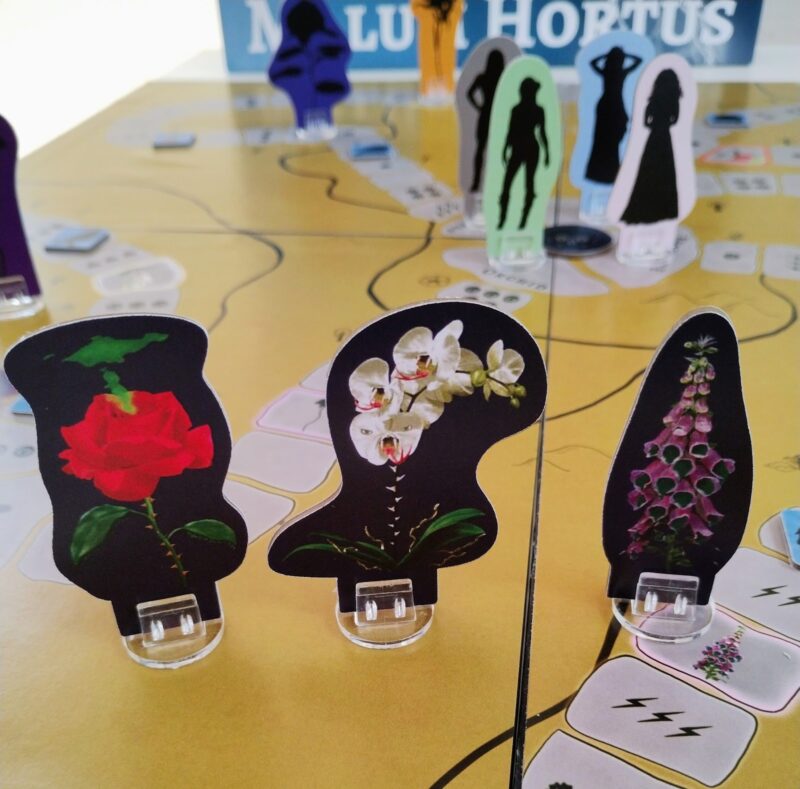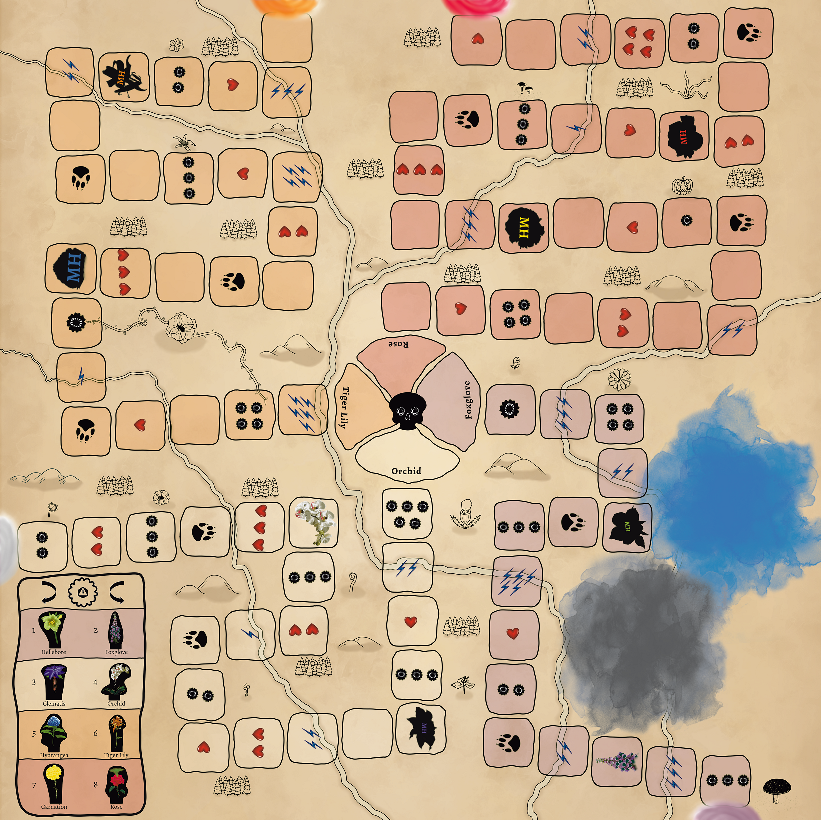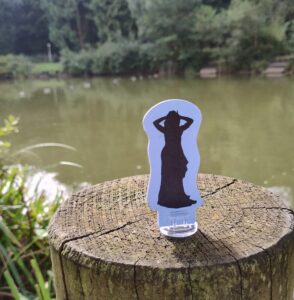
Welcome to the mystical and frightful world of Malus Hortus. In this game you will play as 1 of 4 badass nymphs, each with their own unique powers. Along your journey you’ll meet malevolent flowers, adorable critters and other magical creatures from unknown origins, both friend and foe. Take a look around to determine if you have the bravery it takes to enter Malus Hortus.
To be the first to know when Malus Hortus launches click the ‘notify me on launch’ button on the Kickstarter page.
1-4 players – cooperative play – 30-60 mins – Ages 14+

Previews and Instagram Features
What Board Game
Punchboard
Boardsenseless on Instagram
Favourite Foe on Instagram
Introduction
You wake on the cold and unforgiving ground. Trying not to panic, you take stock; you aren’t injured, nevertheless you can’t remember where you are or why you chose to sleep here. Was it your choice to sleep here? No, you wouldn’t, you know yourself, you would have found shelter and comfort. The last thing you remember is beauty, the sight and scent of such alluring flowers. It seemed like heaven here, so inviting, you never wanted to leave and a chill of dread takes hold of you as you realise that maybe you never will. You remember now, as the sun started to set, you heard roots creaking as they were ripped up from the ground, and those exquisite flowers changed, where once you saw wonder, you instead sew cruel eyes, gnashing teeth and lashing vines.
They have been feeding on your energy, you can feel it, your magic is drained. How will you fight back with such limited magic? You take a deep breath; you know you must pull yourself together if you are going to get out of here. Move during the day, hide away at night and do all you can to break out of this nightmare, to escape Malus Hortus.

Objective of the Game
Malus Hortus is a cooperative game, all players win or lose together. Players are a party of nymphs who have been lured in to this beautiful garden by day, only to find it turns evil at night and does not want you to leave. Do not let the word ‘garden’ fool you, this place is a vast woodland with shifting terrain and it will take many days to find your way to freedom.
The main aim of the game is to work together to ensure every nymph leaves the board, escaping Malus Hortus. Along the way there are evil flowers to avoid and critters to save from the garden.
Magical creatures from many different realms find themselves ensnared by and lost in Malus Hortus; through night cards and critter cards you may encounter some of them along your journey, as well as being affected by the enchantments they use to try and flee. Be warned, not all of them are quite as kind natured as your fellow nymphs, it is not just the flowers of Malus Hortus that you need to fear.
The Gameplay
There are two difficulty levels in Malus Hortus that affect how the game is set up and played: Adventurer and Goddess.
You play as one of four nymphs, each with their own powers and weaknesses. They all have a passive power that takes effect whenever applicable in the game and an active power which costs 2 magic to perform. Each nymph also has two flowers they are weak against and will take extra damage from.

Nymphs start in the centre of the board with four paths leading to freedom: Foxglove, Orchid, Tiger Lily and Rose. The shortest path, Foxglove, is the most dangerous to pass through, with that level of danger lessening the longer the path you use. Only one nymph can use each path, and the spaces along each path have been set up so that those that are more beneficial for each nymphs passive powers also contain one of the flowers that nymph is weak to, balancing the game and providing an extra challenge for seasoned players.

Magic is the main resource in the game, there is a maximum of 20 and it is a pooled resource for all players to use. All magic tokens start in the ‘Untapped Magic Pool’ and are moved to the ‘Active Magic Pool’ as they are earned. Once spent they move back to the Untapped Magic Pool. As it is a shared resource you will have to communicate and collaborate on how it will be spent as well as how to go about earning more as a team.

Each round of Malus Hortus is played in two distinct phases, day and night.
During the day, players use rune stone cards to take actions and move. There are five different rune stones, each with a specific action demonstrated by the symbol in the top left hand corner of the card: gain magic, recover health, sacrifice health, move any nymph in the garden, and move a flower on your path.
Each card also has a movement symbol in the bottom right hand corner. The most powerful rune stones may mean you do not move at all or even send you backwards. Whereas less powerful actions or those that sacrifice health will help you to move through the garden a lot faster.

There are critters along each path on the board, they have been ensnared by the garden and need help to make it out. Saving critters means extra points at the end of the game as well as potential benefits, or consequences from the associated critter card. Once you save a critter and they become a ‘travelling companion’ they will be able to assist you in your escape from the garden.
Players are able to save critters whenever they share a space with one. Movement needs to be planned ahead so that you land on a critter space whilst you have enough magic to save that critter. Saving a critter costs 5 magic but it doesn’t necessarily mean you will have succeeded in your attempt to save the critter.

Each time a player attempts to save a critter, a critter card is drawn, which will have story text describing what happened during that encounter and what actions might need to be taken next. Some critter cards are lucky and the critter is instantly saved, others aren’t so lucky and will require extra effort to save, for instance they may need to spend more magic or sacrifice health, cards, etc.
It’s important to plan with the whole team when to take the extra time and spend the extra magic needed for saving critters. If too much time is spent trying to save critters there is the chance that players may not make it out of Malus Hortus before the final round.

At night the flowers are uprooted, they move based on a D6 die roll. If they move past a nymph, they will drain that nymph’s health by one, if a flower lands on the same space as a nymph the flower will attack, the player rolls a D4 die to determine the damage taken, if the player is weak to that flower the nymph loses an additional health point from the attack.

Once all flowers have moved, a night card is drawn and the story continues, you will read aloud to the group to discover what has happened in the night. There may be immediate actions that need to be taken, or the card may describe what’s to come in the next round.

If a nymph reaches 0 health they are knocked out and sent back to the centre of the garden. They fully regain their health and can choose to follow the same route they were on or any other unoccupied path, but will there be time to make it out from the centre again?
They take the corruption token from the centre of the board, the entire party is now corrupted, which accounts for minus points at the end of the game. This can only happen once, if any nymph in the party is knocked out once the party is corrupted the game is over and lost.

The game ends in one of three ways:
There are no night cards left to draw – you have lost
The party has been corrupted and a nymph loses consciousness – you have lost
All nymphs make it off of the game board and out of the garden before either of the above conditions are met – you win! Total your score!
Points are scored for health and magic remaining, critters saved, night cards remaining and there are minus points if the party has been corrupted by the garden.
Link to full rulebook – coming soon!
Atikin Games
It’s very much a one-woman team, with my mostly hand-crafted games and gaming accessories all designed, illustrated, built, published, etc, etc by me.
Malus Hortus was the second game I ever designed but due to the size of the game and intricacy of the art it will actually be my sixth game to be published. This game deserved the extra time and attention given to make it all that it can be which is why I’m very excited to be bringing it to Kickstarter this year.
Game Art
Each main piece of art for Malus Hortus is a digital painting made by me, with some of the biggest pieces comprising 20+ hours of work, this game really has been a labour of love.
The artwork for this game has been a joy to make, and I am incredibly proud of what I have been able to achieve. I’ve worked on each main piece as high-resolution large format so that they can be made available as prints and potentially even an art book.

Some of the art is still in progress, these appear in the prototype copies as silhouettes of the final artwork, which will take their places once finished.
An All Female Cast

Nomia is an Oread, also known as a Rock Nymph
Passive Power: -1 damage from Plant Spaces
Active Power: Stuns a Flower on your path, a stunned Flower will not move or attack the next time it is uprooted
Weaknesses: Hellebore and Clematis

Chloris is an Antousai, also known as a Flower Nymph
Passive Power: Saves Critters for 1 less Magic
Active Power: Moves a Flower on your path back to the centre space of that path
Weaknesses: Tiger Lily and Rose

Pegaia is a Naiod, also known as a Water Nymph
Passive Power: +1 health from Tree Spaces
Active Power: Heal 2 damage
Weaknesses: Carnation and Orchid

Erato is a Dryad, also known as a Wood Nymph
Passive Power: +1 magic from River Spaces
Active Power: Move one space in either direction
Weaknesses: Foxglove and Hydrangea
Meet the Flowers
There are 8 flowers that feature in Malus Hortus, each has a beautiful day version and a creepy evil night version.

At night this beautiful orchid comes to life, opening its eyes, baring its teeth and snake-like tongue. It pulls its roots up from the ground and pushes out it’s sharp spikes before it comes hunting for you.

The foxglove’s leaves turn to blades, its vines to bladed whips. Green veins show through each flower as toxic liquid oozes from them.

The rose’s sharp thorns stretch out, leaves become serrated and noxious gas emits from the centre of the flower.
Removing Plastics and Other Eco Fun
The prototype copies of the game all include plastic dice and standee stands. My plan for the production copies is to use grey board stands instead of plastic, there will also be wooden dice and cloth component bags instead of plastic zip lock bags as well.
I would like to fund the planting of trees to offset the carbon emissions from having the game shipped to the UK from China. I’m currently in talks with a company that does this to partner with them on this project.
Making Games Comfortable to Play
I’ve always said that I want to make my games as comfortable to play as possible. For instance, for players with colour vision deficiency I make sure to use both colours and shapes to differentiate between any important game elements. I also use software that simulates different types of colour deficiency to check that the art for my games is still clear.
Another way to make games more comfortable for players is to use symbols instead of a lot of text, although this is what I’ve done for the rune stone cards it’s not possible for the critter and night cards as Malus Hortus is all about the little stories going on throughout the garden.
I know many people don’t feel comfortable reading aloud. My solution is to have audio files available on this page once the game goes to production. There will be audio clips for the introduction, each night and critter card and the epilogues.
Malus Hortus Lore
I’ve always loved ancient mythology, be it Roman, Greek, Egyptian, Nordic, it’s all brilliant. I also love all things fantasy and out of the norm so there has been a lot of research on my part into having these magical elements in Malus Hortus.
The idea behind Malus Hortus is that anyone, from any reality, could find themselves drawn into the garden. You’ll find many other fantastical and mythological creatures as you play through the stories on critter and night cards.
I would love to combine an Art and Lore book for Malus Hortus, containing all the art and explaining all the choices made for the flowers, runes, gemstones, and nymphs, with a bit more background into why I thought they were the perfect additions to the game.
To be the first to know when Malus Hortus launches click the ‘notify me on launch’ button on the Kickstarter page.





